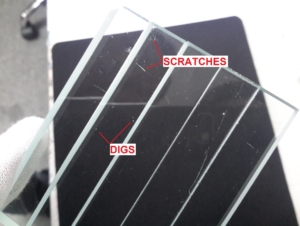Scratch and dig : a detailed explanation
Scratch and Dig, also widely referred as S&D is a common reference for defining optical component surface imperfections quality level.
What does “Scratch and Dig” means ?
It refers to two common defaults on optical parts :
- Scratches : any visible long marking or tearing on part’s surface
- Digs : any small dot, spot or bubble visibly marking the surface
The S&D specification state the acceptable number and size of both defects on an optical surface, it applies for both the coating and the material surface.
Detail of the S&D specification
It is defined by 2 number separated by a slash (/) or a hyphen (-).
S/D | Max. width allowance of a scratch (µm)/Max. diam. allowance of a dig (0.01mm)
Example : S&D 20/10 allows 20µm wide scratches and 0.1mm diameter digs.
Additional limitations:
- The total combined length of maximum-size scratches shouldn’t be bigger than a fourth of the optical usable area
- The allowable number of digs of maximum dimension is limited to one per D20mm area for dig number bigger than 10 and D1mm for dig numbers equals to 10 or lower.
- The sum of the diameter of all digs should not be bigger than twice the maximum allowable dig dimension.
Scratch and Dig chart
| Scratch number XX/.. | Max. scratch width in mm | Dig number ../XX | Max Dig diameter in mm |
|---|---|---|---|
| 120 | 0.12 | 120 | 1.2 |
| 80 | 0.08 | 80 | 0.8 |
| 60 | 0.06 | 60 | 0.6 |
| 50 | 0.05 | 50 | 0.5 |
| 40 | 0.04 | 40 | 0.4 |
| 30 | 0.03 | 30 | 0.3 |
| 20 | 0.02 | 20 | 0.2 |
| 10 | 0.01 | 10 | 0.1 |
| 5 | 0.005 | 5 | 0.05 |
| 3 | 0.003 | 3 | 0.03 |
How to check the surface quality of an optical part ?
Most common way of check scratch/dig quality of an optics is visual inspection, often enhanced by graduated magnifiers / microscopes and can be supported by comparators.
Some companies also provide S/D inspection machines which may help reduce human subjectivity and improve reproducibility of the measure but are not yet widely used.
Which S/D numbers are good for my usage ?
Optical specifications are usually defined by optical designers for a particular application, taking into account the final usage of the optics. For example simple lighting optics may only require a 120/80 specification mostly for cosmetic purpose, while precision optics can be specified down to 20/10.
Critical applications like deep UV optics working at ultra-short wavelength and high power lasers where defects may induce high concentration of energy on a spot may use even lower specifications.
Why scratch/dig definition is important ?
In optics, surface quality is of major importance as it will impact the wavefront of optical signal but also the manufacturing of parts both in terms of manufacturing time and price. Therefore designers and manufacturer need to understand each other expectations and capabilities through widespread norms. S&D standard is coming from the MIL-PRF-138130B norm, but is also widely used in addition to ISO 10110 for defining a optical component quality level.







